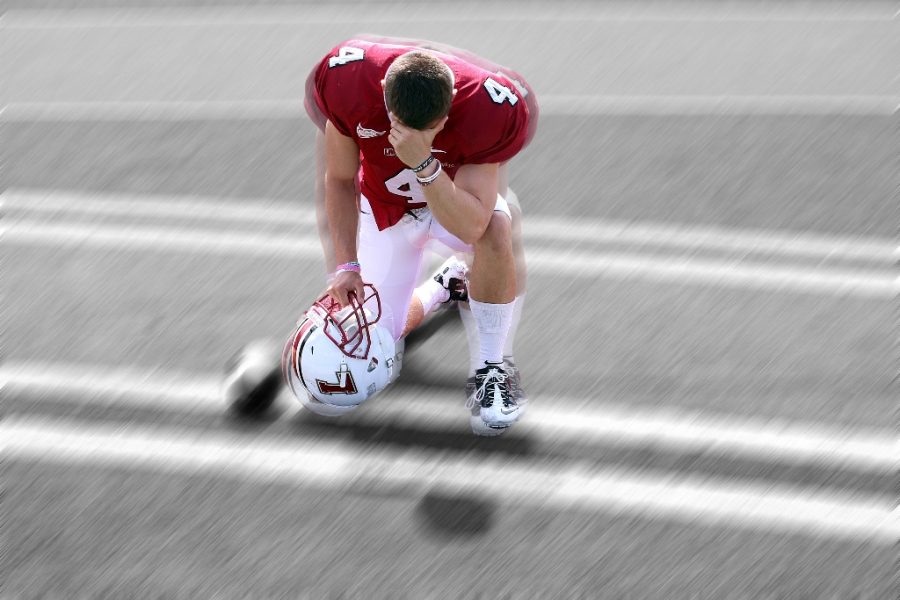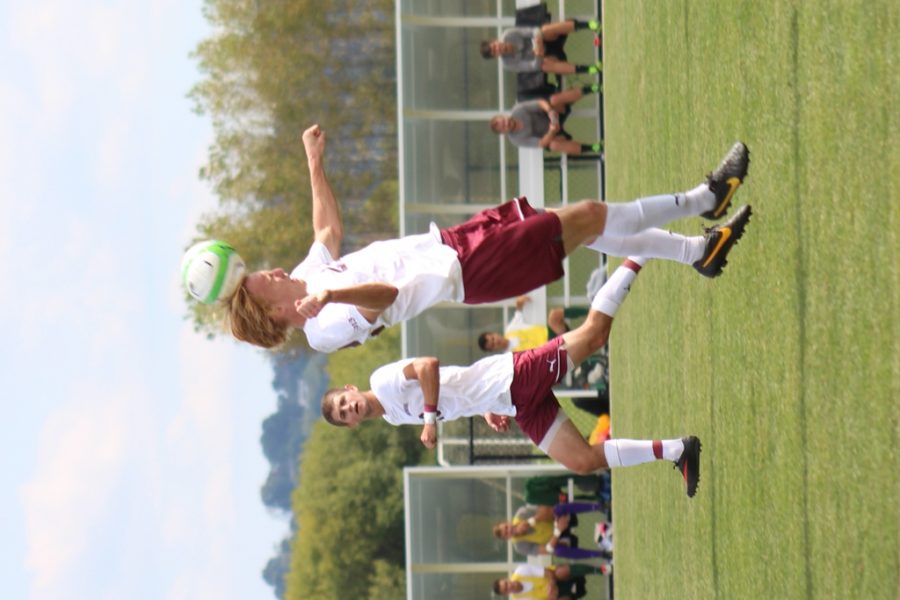Research finds student athletes are at greater risk for long-term health issues
Photos by Austin Drucker ‘17 and Hana Isihara ‘17
Lafayette wide receiver Justin Adams remembered his first concussion in senior year of high school. And then the two that occurred during his sophomore year at Lafayette and the other last season.
The impact since is significant: constant headaches, neck pain, and even depression.
“I can’t tell you a week that I haven’t had a headache,” Adams said. “I’m a pretty upbeat guy and it was the complete opposite – it was a struggle to leave my room each morning.”
Yet Adams is steadfast in playing his senior season, despite his injuries and the example of his father, a former collegiate athlete with bad knees and a torn rotator cuff that was never correctly repaired. Adams could one day join a society of college athletes who endure a future filled with pain and psychological problems.
It is common knowledge that the long-term price of professional sports is joint failure, arthritis, and post-concussion rage and depression. But a recently released study revealed that it doesn’t take a hit from Ray Lewis to seal an athlete’s fate.
Division I college athletes, the research showed, were more than twice as likely to suffer physical limitations later in life than their non-athlete counterparts.
It isn’t just major conference players. From large universities to small colleges, males to females, and football to soccer to rowing – all athletes are at risk.
This painful journey can begin anywhere, even at Lafayette College. An investigation by The Lafayette found that this research definitely applies to this campus.
Interviews with former and current athletes, coaches, administrators and medical experts revealed that although there is real concern for athlete health, play continues. Former Lafayette star players said they suffer ongoing debilitation and worry about their children suffering the same future. One doctor reported a progression in college sports from “bumps and bruises up to major ligament reconstruction.”
Are college athletes properly informed before taking one for the team? Probably not, experts say. But is there a campus climate at Lafayette that admits room for improvement? Fortunately, yes.
“Lafayette’s coaches and trainers care deeply about the health and well-being of student-athletes, and would not knowingly court long-term risks in the service of short-term performance goals.”
– President Alison Byerly
***
“Our department has started a student-athlete well-being committee. Injury prevention is a part of that. Have we sat down to review these particular studies, no.”
– Director of Athletics Bruce McCutcheon
On March 3, the American Journal of Sports Medicine published the study conducted by lead researcher Janet Simon at Indiana University. It compared 232 male and female former Division I athletes to 225 male and female non-collegiate athletes who are now 40-65 years old.
Simon found that former athletes face more limitations in their day-to-day activities and higher rates of depression, fatigue and sleeplessness compared to non-collegiate athletes.
“I met a former Division I athlete who was talking to me about the pain he is in and how he has trouble walking up the stairs,” Simon told The Lafayette. “It got me thinking: are there others out there like him? Is this the norm for former athletes?”
The study received attention from major media outlets such as the National Public Radio, Inside Higher Ed, and The Huffington Post.
Simon has acknowledged that more research must be done. But current findings beg the question of whether or not institutions ask too much of their student-athletes, who are major sources of alumni donations.
Debates loom over an institution’s long-term obligation to former players and how to better protect current student-athletes. In the meantime, however, Lafayette players continue to take the field and courts, led by coaches who grew up in an engrained culture of “tough it up” and “no pain, no gain.”
“From an early age, athletes get programmed to deal with injuries they shouldn’t be playing with,” head women’s soccer coach Mick Statham said. “Deal with it, don’t tell anyone about it, and get through it. Consequently, when they get to college, there is probably a lot of that still lingering.”
“Overall culturally, it has been a badge of courage to suck it up.”
Dr. Nicholas Slenker of Coordinated Health currently works with Lafayette student athletes, both past and current. He served as Assistant Team Doctor for the Los Angeles Lakers, Kings, and Dodgers, and also worked closely with the team doctors for the Philadelphia Eagles and Phillies.
“We know more about prevention now,” Slenker said. “Lafayette has very sophisticated coaches who understand sports medicine. With short-term pains, we don’t see the pushing to tape his knee up and get him back in the game. That does still happen but it happened a lot more in the past.”
“This wasn’t even talked about 20 years ago.”
Slenker added, however: “At the college level, athletes have been progressing from bumps and bruises up to major ligament reconstruction.”
Those interviewed agreed the mentality has shifted, but there is simply no way to avoid injuries in contact sports.
“I think [this research] brings a lot of good things to light,” head football coach Frank Tavani said. “But when you get involved with competitive sports, there are certain aspects that come with it.”
McCutcheon played football and competed in track and field at William and Mary College and agreed with aspects of the research. He now has two “bum shoulders” that do not bother him a great deal, but still provide lingering pain or those “certain aspects” Tavani speaks of.
“What is truly different now is that back then, they didn’t have the type of training regiments, the injury prevention protocols, that current student athletes have today,” McCutcheon said.
“I really wish I would of played nowadays compared to what it was like back then. It wasn’t macho to have a water break. It wasn’t macho to say I had my bell rung and needed a breather. It’s just different now.” – John Orrico ‘78
John Orrico recounted one of his playing memories. Lafayette was playing Colgate on the road and the conditions were extremely humid. The running back recalled touching the ball at least 20 times in the first quarter alone. He walked to the sideline for water and was met by the Lafayette team doctor at the time.
“I remember it vividly,” the former captain said. “He said, ‘You’re fagging out right now, get back in there.’”
“There were times I clearly had concussions. But I had to tough it up and get back into the game or practice,” said Orrico, adding that he never missed a game. “It was a completely different time. The mentality of the sport was so much different then.”
Orrico tries to remain active, but is limited in what he can do.
“I can’t run long distances. It’s impossible. I can’t ski or ice skate. Anything where you have to gyrate on your knees is when mine give out on me.”
Nick Kowgios ‘84 is another former star player, but fortunately does not face limitations in day-to-day activities, although he has some neck discomfort.
Kowgios suffered from hematoma in one of his thighs and was hospitalized for four months in his freshman year. He then broke his forearm his junior season and missed two games, but then “put a soft cast on it and played with it basically.”
Kowgios has a son who is 15 and “he does not play football and I never encouraged him to and I’m glad he doesn’t play. That’s my perspective on it now.”
When asked if either would change their decisions to play collegiate athletics if presented the results of the study before attending Lafayette, both said no.
Current Lafayette senior Kelly Sposato, however, has said she would not have played college soccer if she knew she would suffer 20 years from now. Sposato has suffered an array of injuries in her collegiate career, most notably a torn ACL and meniscus this past season. She is currently rehabbing the injury and said she should “be soccer ready in a couple of months.”
But when asked the same question posed to Orrico and Kowgios, she replied, “my overall health in life is much more important than just four years of playing a sport. With all the physical demand I have put on my body playing goalie, I’m sure I will have issues later in life.”
“I’m going to have to change my game a little bit. I would give the same answer though – there is no doubt in my mind I will play senior year. I love being a part of this team.” – Justin Adams
Adams acknowledged the negative aspects that accompany intense athletics. But regardless of those, he has decided to play his senior season, despite doctors recommending he not play.
“It’s scary. I’m at high risk for another. If I get another there might be some serious consequences,” Adams said. “Every time I step onto the field and strap on my helmet, I think about it.”
But Adams refers to it as the price you pay to do what you love.
“Anything you want to do in life there will be some negative aspect you have to deal with and this is what athletes have to deal with.”
He did say he will take measures to protect his body. That includes getting out of bounds more often instead of lowering his shoulder.
Studies like these will raise the overall education on the issue that is rapidly acquiring national attention. Statham has increased injury awareness and thus prevention on his team over the seasons.
“Don’t ignore [pain],” Statham said. “It’s your body telling you something. One of the things for my players is to get them as educated as possible on their own bodies and that it’s ok to get treatment.”
Following graduation though, student athletes do not have access to the training rooms and equipment provided to them during their careers. They often times fall out of shape and gain weight. And that is exactly what Slenker recommends those athletes avoid.
“Staying active is critical. Stay at the healthy weight,” Slenker said. “The stronger your legs and arms are will prevent arthritis. Bicycle, swim, ride the elliptical, those types of things as opposed to running and high impact activities.”
What is certain is that this issue is far from resolved. Sixty-five former college athletes are currently suing the NCAA over its handling of concussions. These lawsuits are said to be representative of the college players who do not go on to the NFL.
The NCAA and institutions are now both responsible for finding solutions and finding them soon. Coaches are being forced to take more proactive stances and athletes will be informed of the risk up front while encouraged not to play injured.
“It’s ok to report things. These kind of things are critical for college athletes,” Statham said.



















































































































